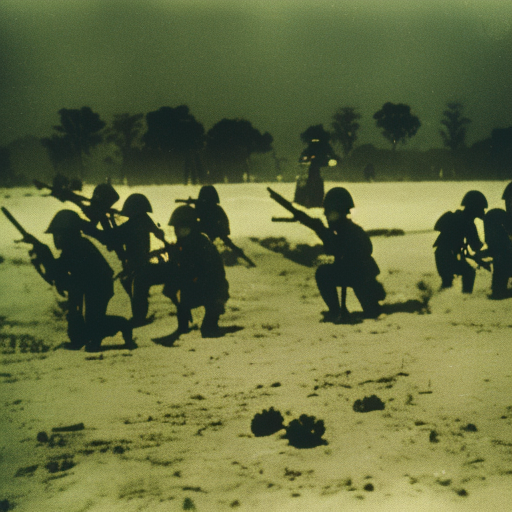Battle of Dien Bien Phu: The Turning Point in the First Indochina War
The Battle of Dien Bien Phu was a significant military confrontation that took place in the First Indochina War between the French Union forces and the Viet Minh communist revolutionaries. The battle, which lasted from March 13 to May 7, 1954, resulted in a decisive victory for the Viet Minh and marked a turning point in the conflict.
Background:
The First Indochina War began in 1946 as the Viet Minh, led by Ho Chi Minh, sought to gain independence from French colonial rule. The French Union forces, supported by the United States, aimed to maintain control over the region. In an attempt to cut off the Viet Minh’s supply lines and force them into open battle, the French decided to establish a fortified base at Dien Bien Phu, located in the northwest of Vietnam near the border with Laos.
The Battle:
The French Union forces, under the command of General Henri Navarre, believed that the rugged terrain and surrounding hills would provide them with a strategic advantage. They established a series of fortified positions around the valley of Dien Bien Phu, including strongpoints named after French commanders such as Eliane, Dominique, and Gabrielle. The French forces were confident that their superior firepower and air support would enable them to repel any Viet Minh attacks.
However, the Viet Minh, led by General Vo Nguyen Giap, devised a plan to surround and besiege the French positions. They carefully positioned their artillery on the surrounding hills and dug extensive tunnel networks to protect their troops from French airstrikes. The Viet Minh also received support from the Chinese People’s Liberation Army, who provided them with heavy artillery and anti-aircraft guns.
The battle began on March 13, 1954, with the Viet Minh launching a series of attacks on the French positions. Despite heavy casualties, the French were initially able to hold their ground. However, as the battle progressed, the Viet Minh’s artillery fire became increasingly accurate, causing significant damage to the French defenses. The French air support, hampered by the Viet Minh’s anti-aircraft guns, was unable to provide effective assistance.
The Fall of Dien Bien Phu:
By late April, the situation for the French had become dire. The Viet Minh had successfully cut off the French supply lines and encircled the base. The French forces were running low on ammunition, food, and medical supplies. In a desperate attempt to break the siege, the French launched a series of counterattacks, but these proved unsuccessful.
On May 7, 1954, the Viet Minh launched a final assault on the French positions. Overwhelmed and outnumbered, the French defenders were quickly overrun. The fall of Dien Bien Phu was a devastating blow to French morale and marked the end of their involvement in Indochina.
Impact:
The Battle of Dien Bien Phu had far-reaching consequences. The French defeat led to the signing of the Geneva Accords in July 1954, which ended the First Indochina War. Under the terms of the agreement, Vietnam was temporarily divided at the 17th parallel, with Ho Chi Minh’s communist forces controlling the north and a pro-Western government ruling the south.
The battle also had a significant impact on the United States’ involvement in Vietnam. The French defeat at Dien Bien Phu highlighted the challenges of fighting a guerilla war in the region and influenced the U.S. decision to increase its military support to the South Vietnamese government in the coming years.
In conclusion, the Battle of Dien Bien Phu was a decisive victory for the Viet Minh and a turning point in the First Indochina War. The French Union forces’ defeat at Dien Bien Phu led to the end of French colonial rule in Vietnam and set the stage for the subsequent Vietnam War.












